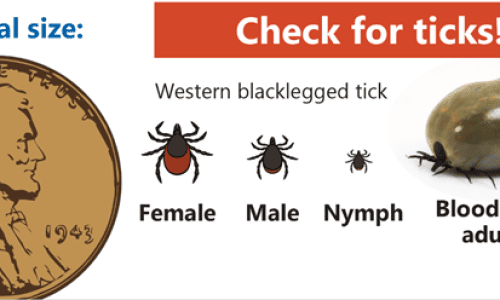By: Dr. Veja Tillman, DVM
Lyme disease is a bacterial infection caused by the bacteria Borrelia burgdorferi. Transmitted through the bite of a tick, it affects domestic animals (dogs, horses, and possibly cats) and humans.
At least 4 known species of ticks can transmit Lyme disease. However, the great majority of Lyme disease transmissions are due to the bite of a very tiny tick commonly called the deer tick, or black-legged tick. It is important to note that ticks themselves do not cause Lyme disease; they harbor and transmit the bacteria that cause it. Lyme disease is not transmitted from one pet to another, except through tick bites. Humans get Lyme disease through tick bites, and not from infected pets.
Lyme disease has been reported in every state in the United States, but certain geographical areas are much more likely to harbor bacteria-carrying ticks than others. Infection rates of ticks vary but can be as high as 50%. Areas in the United States where it occurs most often include the northeast (especially the New England states), upper Midwest, and the Pacific coast. However, due to increased travel and relocations from these areas, infections are quickly rising in the southeastern states.
SIGNS, DIAGNOSIS AND TREATMENT
Once a tick bites and attaches, it takes 1-2 days for it to transmit the bacteria that cause Lyme disease, so prompt removal of ticks is important. Risk of transmission is highest during periods when the nymphs (Spring) and adults (Spring and Fall) are actively seeking hosts to feed on.
The most common signs of Lyme disease are high fever, limping (that comes and goes or shifts from limb to limb), swollen painful joints, loss of appetite, lethargy, confusion, and seizures. These signs may be mild and easily overlooked. Pets may not show signs of illness for weeks or months after an infected tick bites them –and many that are infected never show signs of illness until after the infection has caused injury to other part of the body. More serious signs develop as the disease progresses: kidney disorders, heart disorders and nervous system disease.
The diagnosis of Lyme disease is often based on the presence of signs of the disease, history of exposure and a favorable response to treatment. For example, a veterinarian might suspect Lyme disease in a pet with recent lameness, a mild fever, and a history that includes a recent tick removal. Antibodies against the disease-causing bacteria can often be detected in blood work 4 to 6 weeks after the initial exposure and help confirm the diagnosis.
Lyme disease is easily treated with antibiotics for pets that have signs. A rapid response is seen in limb and joint disease in most cases. Although incomplete resolution of signs is seen in a significant number of affected pets. Additional therapy to help the affected organ systems and signs is important, especially when the disease affects the kidneys, heart, or nerves. Some affected pets will experience chronic, lifelong joint pain from the damage caused by the bacteria.
PREVENTION OF LYME DISEASE KEY POINTS• Pets should be treated with a readily available, effective, tick-control product at regular intervals. Ask your veterinarian to recommend the best product for your pet. • In areas where Lyme disease is common, vaccination for Lyme disease for dogs should be given at regular intervals. Vaccination of your pet may depend on where you live, your pet’s lifestyle and overall health, and other factors. There is no vaccine currently available for cats.• Routinely check your pets for ticks after they have been outside, especially if they have been in tall grass and brush during the Spring, Summer and Fall. If any ticks are found they should be gently removed.• Regularly brush your brush your pets. Watch carefully for any ticks that may be removed. Capture and dispose of them before that can reattach to your pet or migrate to other pets in the home or people. • Keep lawns well maintained and clear shrubbery next to homes.
May is Lyme disease prevention month. Make an appointment with your veterinarian to discuss Lyme disease and tick control for your pets.
ABOUT DR. VEJA TILLMAN, DVM
Dr. Tillman is a 2002 graduate of Tuskegee University School of Veterinary Medicine. Her veterinary practice and work experience focus on patients at emergency and critical care centers in Southwest Florida. She is the owner of Just 4 Pets Wellness Center and can be reached at 239-270-5721.








